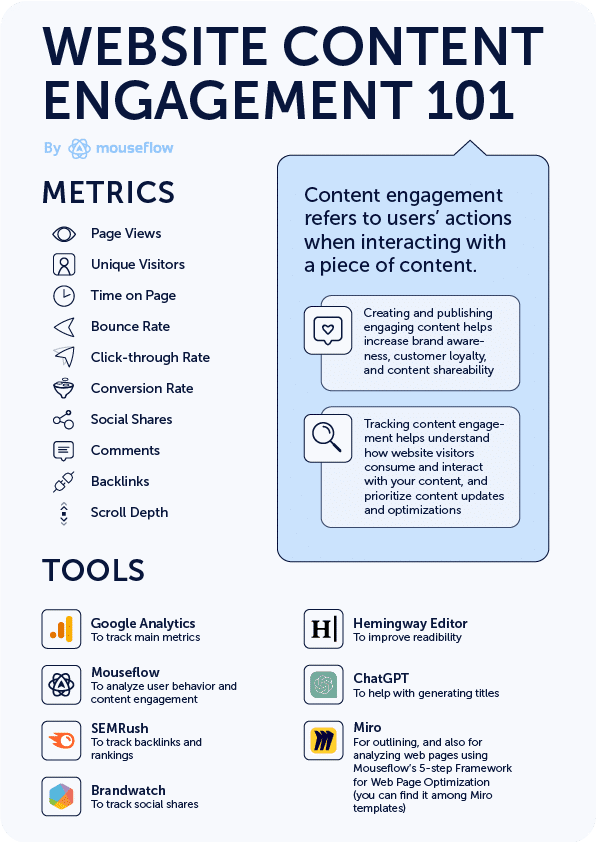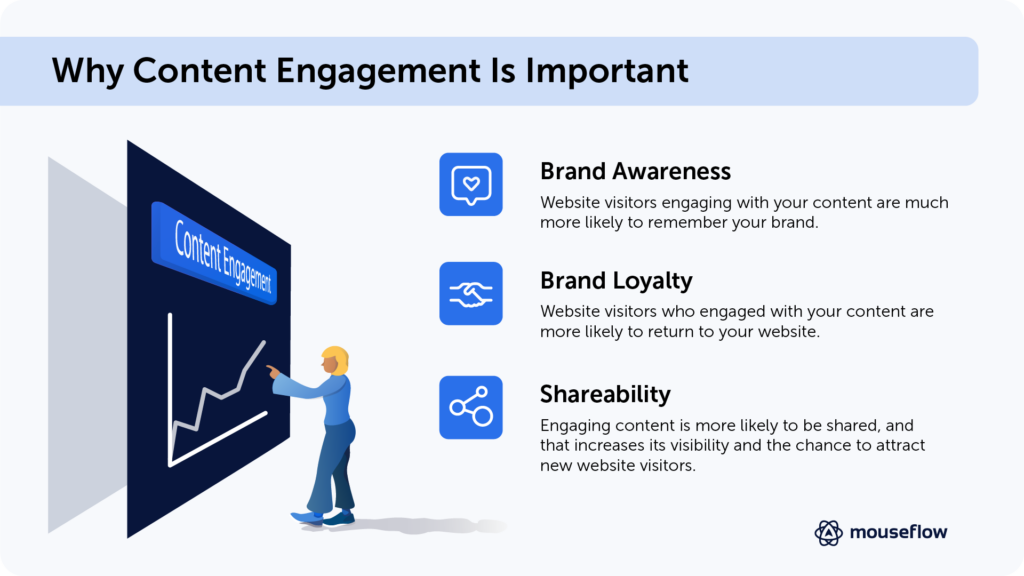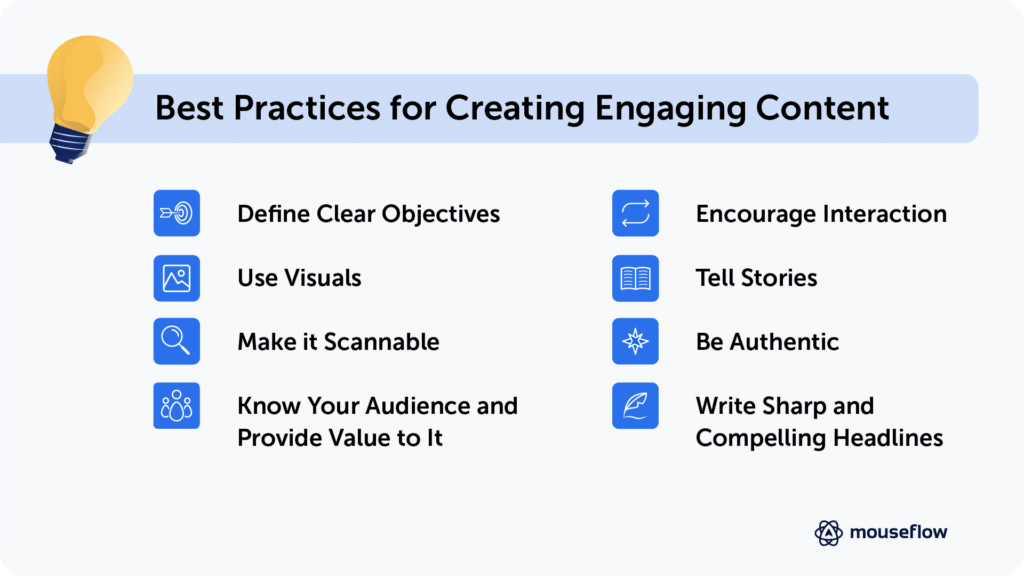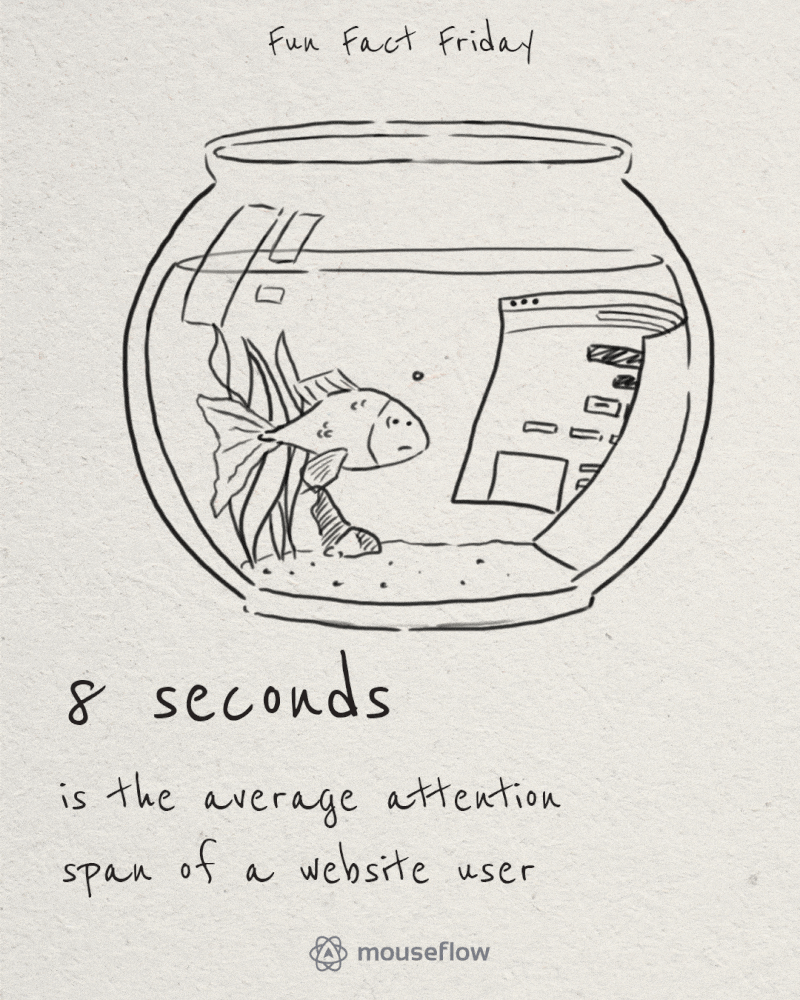Alright, you’ve published a web page with some content. Good job! That content has a goal, right? It has to convert, captivate, be engaging! And the more engaging it is – the better. How do you achieve that? We answer that question in this post!
But before we dive into best practices for creating engaging content, let’s first stop to talk about what exactly content engagement is and how it’s measured. It’s… quite a tricky term.

What is Content Engagement?
The term content engagement refers to users’ actions when interacting with a piece of content.
Content engagement may be seen as a signal sent by the user that informs the website owner, the search engine, or the social platform that the content was relevant for the audience that it reached.
There can be a broad variety of these signals. For example, a user may click a link that leads to another page, or a sign-up button. If the content piece is a video, then clicking play or pause is also engagement, as well as jumping a couple of minutes forward. Actually, just pausing to read a paragraph in an article or turning a page in a book also are actions taken by users while consuming content. So, that’s also engagement.
How to Measure Content Engagement?
Since content engagement is a very broad term, you may want to introduce different metrics to measure the type of engagement that you are interested in. Below, we list some of the most widely used metrics that you may want to consider when it comes to content engagement.
Top 10 Content Engagement Metrics
1. Page Views
The number of times a page is viewed by visitors. It’s the default metric to measure content performance. That’s a good metric to understand the overall popularity of the content – the more pageviews, the more popular the content piece is.
However, it’s never sufficient to use just it – if you’re looking only at page views, you don’t know if your content solves the problem for your website visitors, if it converts, if it drives them to learn more, etc. So, while you can’t avoid using page views as a metric, it’s more about general content performance rather than engagement specifically. Some content managers even call it a vanity metric.
2. Unique Visitors
The number of individuals who visited a certain page on a website. One visitor can generate multiple page views – and that is the difference with the previous metric. The number of unique visitors is a good metric if you want to understand whether your content is reaching new people, or if the same people keep coming back to it.
3. Time on Page
The average time a user spends on a page. Theoretically, the more should mean the better, as it means that the users seem to be spending time consuming your content. But this metric is tricky: If your content is just explaining a certain term in a couple of sentences, your goal is absolutely the opposite: the faster your website visitors grasp the idea – the better.
So, use this metric only to evaluate long-form content. For example, this is one of the key metrics for pharmaceutical companies with websites dedicated to medication or disease prevention.
Another good use of this metric is to filter out bots. Using our own session recording tool, we’ve learned that sessions with just one page per session and with exactly 10 seconds spent on the website are bots. Knowing that, you can ignore such sessions and get more clear stats on real website usage.
4. Bounce Rate
The percentage of users who leave a website without taking any action. The fewer people bounced, the more engaging your content was for them, as it made them perform another action. Usually higher bounce rate means that visitors are not finding what they are looking for.
5. Click-Through Rate (CTR)
The percentage of users who click on a specific link or call-to-action on a web page. You may want to track CTR for different elements on the page, be it the main call-to-actions (CTAs), some links embedded into the text, or snippets for further reading after the article.
6. Conversion Rate (CR)
The percentage of users who complete a desired action, such as making a purchase or filling out a form. This metric is bread and butter for eCommerce and SaaS companies. Optimizing conversion rates for web pages can have a huge impact on their profitability.
On our own website, we track a lot of different conversions such as sign-ups, interactions with forms, downloads, and more. We have set up a custom tag in Mouseflow for each type of conversion. That simplifies tracking, and also allows us to understand what makes the users convert much better, for example, by watching session recordings of the users who decided to interact with forms.
7. Social Shares
The number of times content is shared on social media platforms. On the one hand, that metric indicates whether people perceive the content as interesting. On the other hand, it’s a tricky one. Memes get shared on social media much more often than serious scientific articles. In his Fortune article, Gregory Galant points out that people often share something without reading (and read without sharing). So, by no means shares should be a primary metric, unless your website is all jokes and memes.
8. Comments
The number of user-generated comments on a piece of content. That’s a great metric for user engagement, as people expressing opinions and thanking you for creating the content likely have spent enough time consuming it. However, you don’t necessarily need to have comments enabled on all sites, as they require moderation, and that’s hard work.
9. Backlinks
The number of other websites that link to a particular piece of content. That may indicate its popularity and authority. Also, backlinks are a backbone of ranking higher on search engine result pages, which, in turn, results in more pageviews, unique visitors, etc.
10. Scroll Depth
The average percentage of a webpage that users scroll through before leaving or navigating to another page. This metric indicates whether users are interested in your content – they don’t necessarily read, but at least they looked through it to, perhaps, find a part that interests them and pause there.
Bonus: 11. Friction score
A custom score calculated by a behavior analytics platform (such as Mouseflow), representing the quality of website users’ experience. It takes into account friction events such as click-rage and click-error, bounces, speed browsing, and more. A higher friction score means that website visitors are less pleased with the experience they have on the page. Friction score can be tracked for the website as a whole, for individual pages, and for individual sessions.

Tracking Content Engagement
You need a website analytics system to track the metrics you choose. But most likely, you won’t be able to get away with just one tool. For example, while tools like Google Analytics allow you to track most of these metrics, for scroll depth it’s better to use a behavior analytics tool like Mouseflow (which also gives you attention heatmaps that are priceless for understanding content engagement and user behavior).
For backlinks, you’ll need an SEO tool such as Semrush or Ahrefs. Tracking social shares manually is too tedious, so it’s better to automate it as well using social listening tools such as Brandwatch. You can find out more about content optimization tools in this post.
Also, there is no unity across content marketers about which engagement metrics are the right ones. For example, Andrew Raso in Content Marketing Institute’s article promotes prioritizing conversions over sessions, scroll depth over time on page, and comments over social shares.

However, conversion rate is no less important than conversions themselves (tracking and comparing CR across pages helps you understand if some pages are underperforming and should be optimized). And some content marketers prefer using hybrid metrics, for example, I used to track sessions with 50% scroll depth and at least a minute of time on page at one of my previous companies. If such a session happened, we (automatically) marked it as a meaningful engagement.
Your choice of metrics should be based on your goals. Whether it’s increasing sales, growing customer satisfaction rate, making people subscribe to your newsletter, or something else, you need your content to be engaging – but in a different manner.
8 Best Practices for Creating Engaging Content
In the best case scenario, the content that you publish should be engaging right away. There are some best practices that you can follow to try achieving this goal.

1. Know Your Audience and Provide Value to It
Understand who your target audience is, their preferences, and what interests them. Tailor your content to their needs and desires – and enjoy high levels of engagement.
One of the best ways to get to know your audience is by watching session recordings and exploring heatmaps, and you can read about it in some more details in a blog post dedicated to our 5-step Web Page Optimization Framework.
A lot of marketers underestimate the importance of understanding the audience. In the world of information abundance, people value the content that is tailored for them and help them solve their specific problems.
This is one of the reasons why knowledge of your user and buyer personas is priceless, and if you have an option to at least participate in interviews with people who you expect to consume your content and use your products – absolutely do it, and as often as possible.
2. Define Clear Objectives
Each piece of content can’t do it all: people who get immersed in longreads won’t click, and those watching videos are unlikely to read. So, before creating a piece of content, you may want to understand what you want people who would consume it to do.
Let me break the fourth wall here: This article’s goals, for example, are to educate you about content optimization – and then interest you in trying out our free 5-step Framework for Web Page Optimization (that’s a conversion).
Choosing the objectives influences the metrics that you would want to track. For this article, I’m tracking page views, scroll depth (as an indicator that you were reading the article), and CTR of links leading to the aforementioned framework.
3. Write Sharp and Compelling Headlines
According to the Pragmatic Institute, you have about 10 seconds to grab the visitor’s attention (and 0.5 seconds to form an opinion about a site). And nothing grabs it like a good headline with clear value or an interesting twist. In Hubspot’s Content Marketing Course, Justin Champion suggests to always write several titles for each content piece, and then pick the best one (and use the others for content syndication, but that’s another story).

A good headline either clearly explains what a visitor should expect, or contains a hook that would trigger some emotions from the user, or both.
Imagine if this article was called “You Disrespect Your Audience by Not Tracking Content Engagement” – would that trigger some emotions? Would it make you open the article, because you either disagree with me or fear that I may be right? That’s a hook. But this hook provokes negative emotions, and for a brand it’s usually not a good thing to do so. This is why the article has a much more calm title that hopefully gives you a good idea on what it is about.
The best practice for writing headlines is to first write the main body of the article (or the script for your video) – and only then come up with the title. Otherwise the title may influence the content heavily. For many, coming up with a title is a hard task. To overcome this, you can use AI assistants such as ChatGPT (and we have some helpful prompts for you) to generate a variety of titles for your content and use them as a starting point for coming up with a perfect title.
4. Use Visuals
Reading is not everybody’s favorite way of consuming content. So, images, videos, and infographics can help people to better understand your message. Also, they break those long walls of text, making your content more aesthetically pleasing (and shareable – as a bonus).
5. Make it Scannable
People don’t read anymore on the internet – they scan, and that’s something that happens much faster. Nielsen Norman Group’s study dating back to 1997 suggests that even back then 79% of people scanned pages instead of reading. So, your content should be easy to scan if you want people to consume it.
That means using subheadings, bullet points, and short paragraphs to make your content more digestible and accessible to readers. The aforementioned visuals also help a lot, and so does white space between paragraphs and chapters. All of that helps break walls of text as well, and those walls are the least scannable thing ever.
6. Encourage Interaction
If conversion rate is your primary engagement metric, make those CTAs stand out and encourage people to click them. If it’s comments, ask visitors questions and propose to leave answers in the comments section. More often than not it doesn’t hurt to explicitly encourage people to do what you want them to.
7. Tell Stories
We, humans, are naturally drawn to stories. So, use storytelling to captivate your audience, evoke emotions, and create a deeper connection with them.
It’s not always possible to tell a story, especially if you’re creating content that is not suited for storytelling – documentation, for example. But if it is possible to incorporate some storytelling elements into your content piece, that may be something that you should try. Add characters. Bring in problems that people can relate to.
However, don’t let your attempts at storytelling get in the way of making your content clear and concise. If people were looking for instructions, they wouldn’t appreciate going through a drama in five acts.
8. Be Authentic
It’s important to not tell stories that don’t resonate with you, or use someone else’s voice. Authenticity builds trust and helps your audience relate to your story. So, be yourself, share personal experiences, insights, and unique perspectives. That makes for a better story – and higher value.
Closing Remarks
The bad news is that it’s not so easy to produce good content and hit all those sweet spots right away. The good news is that you have more than one try to make things right (unless it’s an email that you can’t change after you’ve sent it). So, even if the first attempt at creating engaging content fails, don’t hesitate to get back to it and adjust it.
You can revisit your content to tailor it better to your audience, make it easier to read or watch, change headlines, add images, adjust CTA placements, and so on. According to Semrush’s content marketing statistics study, 42% of respondents admitted that updating existing content has boosted their content marketing value. So, give your content another chance!
Bonus track: Increase Content Engagement in 5 Simple Steps
All best practices and metrics are great, but… where do you start with all that engagement optimization? We have a framework for that that we are happy to share with you.
Hope you enjoy it!
FAQ
Clicking a link or a CTA, pausing or playing a video, responding to a quiz, filling in a form – all of that are examples of engaging with content.
Content engagement helps move your website visitors down the funnel, and also gives you a better perspective on what it is that they are looking for. Also, visitors engaging with your content are much more likely to remember your brand than the ones that bounced, so improving content engagement also helps to improve brand awareness.
On social media, engagement is limited to a very narrow spectrum of actions permitted by this social media. Usually it’s likes, shares, clicks, and comments, while for web pages the spectrum of possible engagement types is much broader. On the other hand, thanks to this narrow amount of actions, social media platforms provide users with detailed reports on engagement. Compiling such a report for a website is much harder, as tracking different types of engagement requires different tools.

